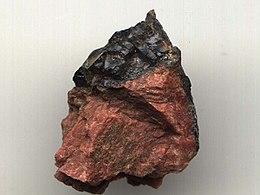| Gadolinite | |
|---|---|
 Gadolinite (black portion at top) | |
| General | |
| Category | Nesosilicate |
| Formula (repeating unit) | (Ce,La,Nd,Y) 2FeBe 2Si 2O 10 |
| Strunz classification | 9.AJ.20 |
| Crystal system | Monoclinic |
| Crystal class | Prismatic (2/m) (same H-M symbol) |
| Space group | P21/n |
Gadolinite, sometimes known as ytterbite, is a silicate mineral consisting principally of the silicates of cerium, lanthanum, neodymium, yttrium, beryllium, and iron with the formula (Ce,La,Nd,Y)
2FeBe
2Si
2O
10. It is called gadolinite-(Ce) or gadolinite-(Y), depending on the prominent composing element (Y if yttrium predominates, and Ce if cerium). It may contain 35.5% yttria sub-group rare earths, 2.2% ceria earths, as much as to 11.6% BeO, and traces of thorium. It is found in Sweden, Norway, and the US (Texas and Colorado).
Characteristics
Gadolinite is fairly rare and typically occurs as well-formed crystals. It is nearly black in color and has a vitreous luster. The hardness is between 6.5 and 7 on the Mohs scale, and the specific gravity is between 4.0 and 4.7. It fractures in a conchoidal pattern and streaks grayish-green. It was also thought to exhibit pyrognomic properties, as it can emit visible light when heated to relatively low temperatures, but the scientific consensus is that this is the product of thermoluminescence[1][2]
Name and discovery
Gadolinite was named in 1800 for Johan Gadolin, the Finnish mineralogist-chemist who first isolated an oxide of the rare-earth element yttrium from the mineral in 1792. The rare earth gadolinium was also named for him. However, gadolinite does not contain more than trace amounts of gadolinium. When Gadolin analyzed this mineral, he missed an opportunity to discover a second element: the element he thought was aluminium (alumina) was in fact beryllium (beryllia), an element that was not officially identified until 1798.
Uses
Gadolinite and euxenite are quite abundant and are future sources of yttrium sub group rare earths. At present, these elements are recovered from monazite concentrates (after recovery of ceria sub-group metals).
See also
References
- ^ https://pubs.usgs.gov/bul/1064/report.pdf
- ^ Schwartz K., Lang M. (2016) Mineral Defects. In: White W. (eds) Encyclopedia of Geochemistry. Encyclopedia of Earth Sciences Series. Springer, Cham